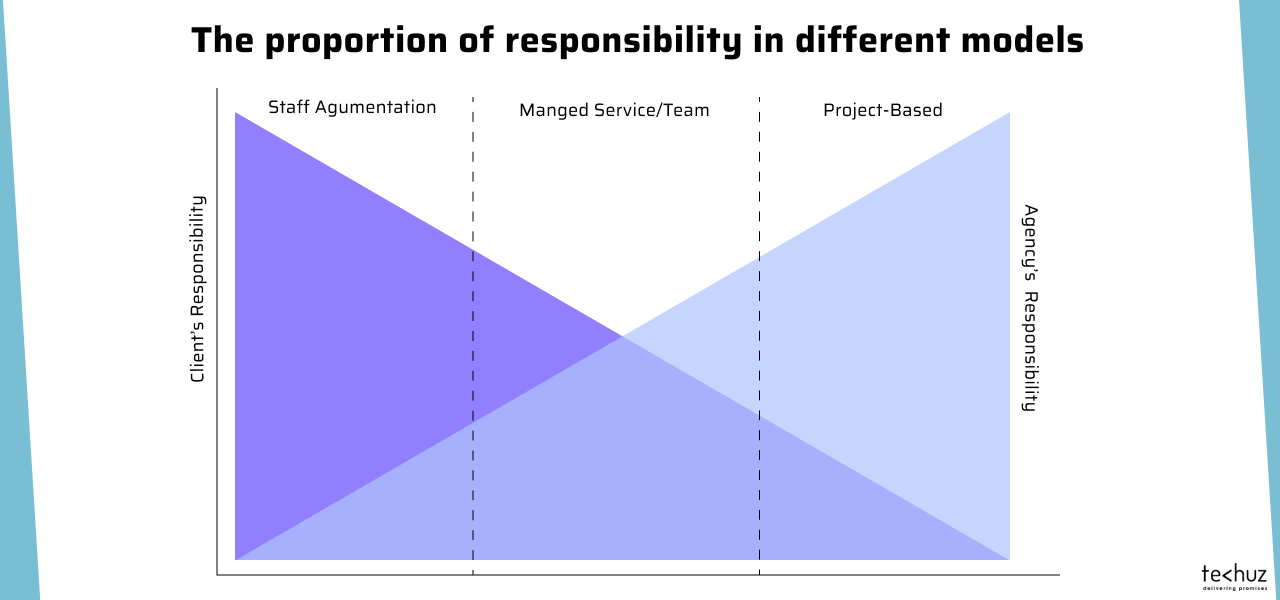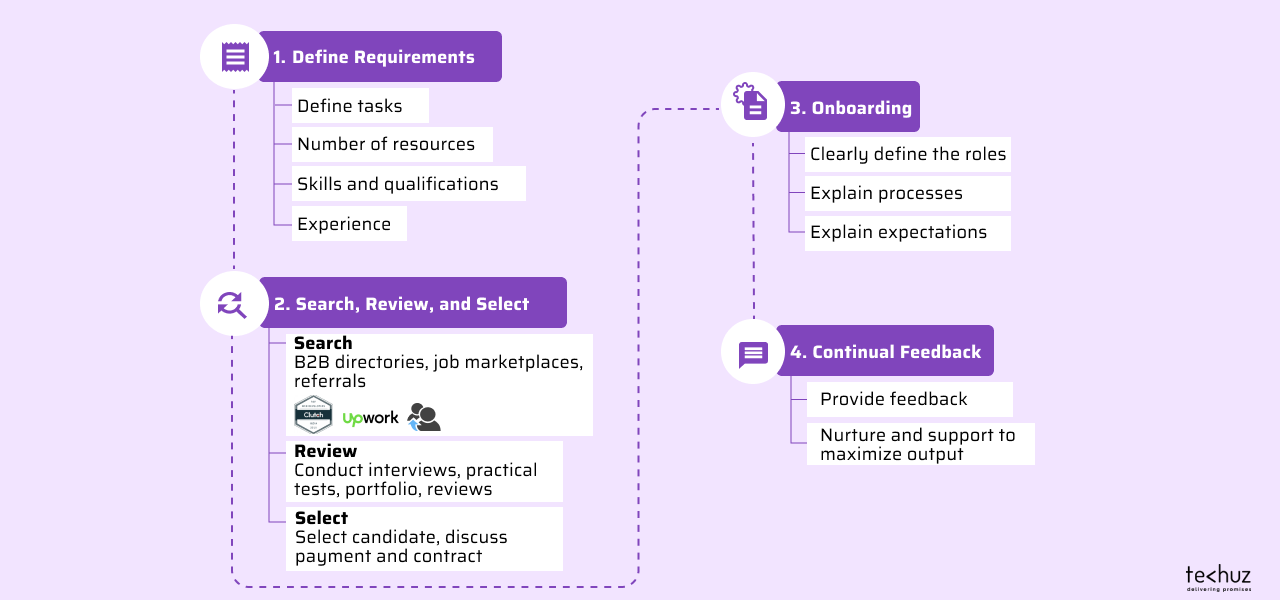Posted on
September 3, 2021
Updated on
March 20, 2024
Read time
 8 mins read
8 mins read
Staff augmentation is a popular outsourcing approach to fill the skill gap and enhance the in-house team’s capabilities. It’s an ideal strategy for businesses looking to hire external resources but wants to keep control of the outcome in their hands. When applied to the right project and business needs, it can be a powerful approach for accomplishing business goals.
If you are looking to get started with staff augmentation, this article is all you need. In this article, we’ll go through the following:
- What is Staff Augmentation?
- Benefits of Staff Augmentation
- Staff Augmentation vs Other Models
- When Should You use Staff Augmentation?
- How to Implement Staff Augmentation to Your Project
What is Staff Augmentation?
Staff Augmentation, also known as Team Augmentation, is an outsourcing model in which you hire external talents from a staff augmentation or web development company on contract basics. This borrowed staff works closely as an extension to your in-house team to meet your project requirements. You also retain complete control over the team and project. This means you’re responsible to manage the extended team, the workflow, as well as the project outcome.
Moreover, staff augmentation allows you to have maximum efficiency by integrating top talents in your team and at the same time gives you the flexibility to keep them on board for however long you need.
Benefits of Staff Augmentation
1. Cost Efficiency
The major reason why companies outsource is to cut costs. And staff augmentation is highly efficient in it. Hiring a new in-house team member brings along several expenses including office space, device and hardware expense, software and tools expense, etc. And not to forget about the employee benefits and the increasing salary with the increased experience. All these are significantly cut down when you lease team members from a staff augmentation company.
Additionally, you can further cut down costs by hiring staff from countries with cost-efficient rates. Countries like India are known for providing world-class development services at a significantly less price than other countries.
2. Flexibility
At times, you may need faster development to meet the tight deadline, time to market, and fulfill the customers’ needs. Staff augmentation makes it easy to ramp up your development process by adding members to your team on-demand without any lengthy hiring process. Further, when the workload reduces, it’s also easier to scale down and optimize your team to save costs.
3. Get top talents around the world
Many times, geographical locations can be a barrier to get the talents you need. The required skills and expertise might not be available in your region or even country. Staff augmentation can help you with it by extending your team with skilled members accessible around the globe.
4. Full control and ownership
This is one of the primary reasons companies opt for staff augmentation. Although they hire external team members to work on the project, the complete control of managing, guiding the team members and the project is in the hand of the clients. This gives them full ownership and control.
Staff Augmentation vs Other Models
The relationship-based outsourcing model describes how the responsibility of the project is shared among the client and the vendor. Staff augmentation falls under this model.
Two other popular models — managed-service and project-based software outsourcing also come under the relationship-based models. Let’s understand how these two models are different from staff augmentation so that you can make the right choice.
Staff Augmentation vs Managed Service
The major difference between staff augmentation and other models is the share of responsibility. In staff augmentation the complete ownership and responsibilities of outcome are in the hand of the client — the extended team just provides the input as per the instructions. While in managed service the responsibilities and ownership are shared by both the client the outsourcing company. In managed services, the client and the company both decide the responsibilities to share and take ownership of the outcomes of the project.
Staff Augmentation vs Project-Based Model
In a project-based model the entire responsibility, from the start to finish, is taken by the outsourcing company. The client just has to provide the project requirements initially and feedback on the completed task. Staff augmentation and project-based models can be said to be the extreme end of the relationship-based spectrum.

(Proportion of responsibility in different models — While in staff augmentation, the majority of the responsibility is in the hands of the client, project-based is its extreme opposite — the outsourcing agency bears the responsibility. And in managed service/team model, the responsibilities are discussed in advance and shared by both.)
When Should You Implement Staff Augmentation?
Staff augmentation yields the best results for certain projects and scenarios. You should use this outsourcing model in the following cases.
1. You already have an in-house team
There’s a reason why it’s called staff ‘augmentation’ — you’re adding or improving your current team with more talents. If you don’t already have a team or looking to make a team from scratch, there are outsourcing models that are more useful.
2. You need specialized skills temporarily
If your project requires experts with specific skills, but you don’t want to hire them permanently, then staff augmentation can help you hire the skilled resource on-demand and contractual basics.
3. You want to speed up the project
When you have to meet tight deadlines or speed up the time to market, staff augmentation is the ideal way to get talents for the needed boost.
4. You want complete control over the project
Gaining control is the very essence of staff augmentation. When you hire the resources from a staff augmentation company, an extended team works just like your in-house team with you being in total control. So managing and directing them for the desired outcome is in your hand.
5. You already have a leadership team
Since you need full control, you’ll need the in-house leadership that can guide and manage the team. It’s ideal to have a tech lead, project manager, or CTO who can instruct and manage the extended team.
How to Implement Staff Augmentation to Your Project

1. Define your requirements
Before you start searching for the ideal staff augmentation company, you’ll need to have a clear understanding of your requirements. This includes defining the tasks, the precise number of resources, required technical skills, preferred experience, and qualifications.
2. Search, review, and select
Once the requirements are defined, start searching the candidates to fulfill the needs. Check B2B directories, search online job marketplaces, get referrals from your personal network, or simply search for service providers on Google.
After you have a list of the companies and candidates, you’ll need to review them to get the ideal fit for your project. Go through the individual candidate’s profile, conduct interviews, conduct practical tests, check the company’s background and portfolios, check their review, etc.
Based on the review process select the ideal candidate, discuss the payment, contract, and other important details before onboarding them to the team.
3. Onboard the new team members
Now once the newly hired resources are part of your team, help them understand your expectations, project goals, define their roles, your company processes, and procedures. This ensures they are on the same page and work to successfully achieve the project outcome.
5. Provide continual feedback
The new team members work closely for your project’s success — they are a part of your in-house team. So offer them help, feedback, cooperate, and nurture them to maximize your project output.
Things to Consider While Staff Augmentation
- Safeguarding with NDA. It’s highly recommended to sign an NDA — nondisclosure agreement with the contractor for sensitive and confidential projects.
- Team availability. Sign a contract to ensure that the hired resources are available until the completion of tenure. And in case you’re expecting to scale up or down the members during the project, it’s always better to discuss in advance.
- Candidates are directly employed by the vendor. For smooth project execution, you need to ensure the candidates you are hiring are employed by the staff augmentation company. Companies outsourcing their work to independent workers can sometimes create mismanagement in the project.
Wrapping Up
Here’s a quick recap: Staff augmentation is an ideal outsourcing approach to scale up or fill in the skill gaps of your in-house team. It brings a lot of benefits including cost-efficiency, flexibility, and control. When used for the right projects, it can help you achieve your project and business goals.
Hope this article has given you a good understanding of the staff augmentation model. At Techuz, we provide various development-related outsourcing services including staff augmentation. We have a team of over 55 tech professionals who work closely with the client’s core team to add value. If you’re looking to extend your development team with skilled resources, we can help. Just drop us a line and we’ll get back to you.








